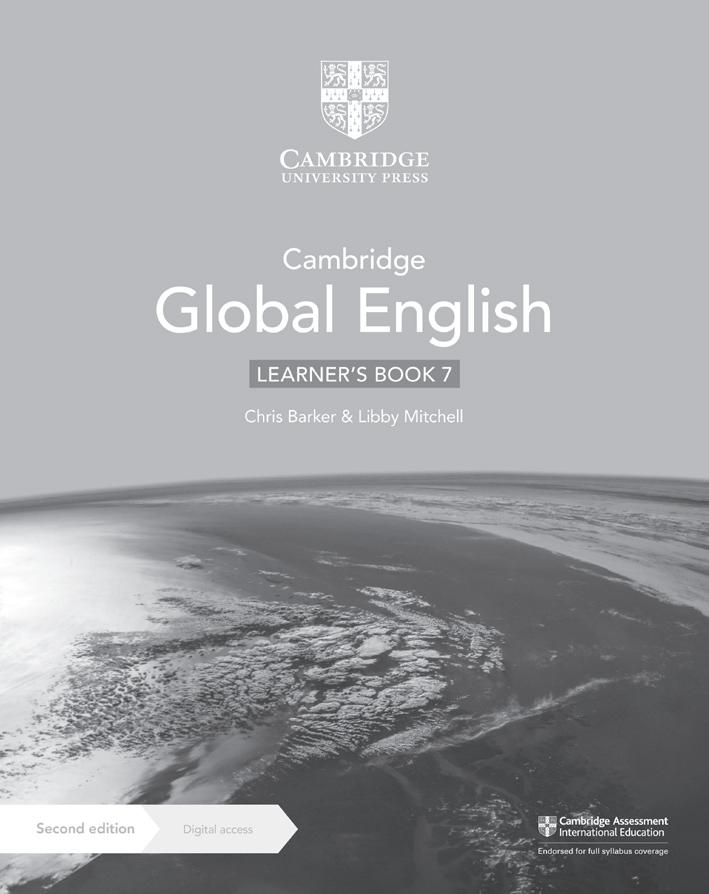
14 minute read
How to use this Teacher’s Resource
This Teacher’s Resource contains both general guidance and teaching notes that help you to deliver the content in our Cambridge Global English resources. Some of the material is provided as downloadable files, available on Cambridge GO. (For more information about how to access and use your digital resource, please see inside front cover.) See the Contents page for details of all the material available to you, both in this book and through Cambridge GO.
Teaching notes
This book provides teaching notes for each unit of the Learner’s Book and Workbook. Each set of teaching notes contains the following features to help you deliver the unit.
The Unit plan summarises the lessons covered in the unit, including the number of learning hours recommended for the lesson, an outline of the learning content and the Cambridge resources that can be used to deliver the lesson.
Lesson Approximate Outline of number of learning content learning hours 1 Meeting and 1.75–2 Talk about greeting customs of meeting and greeting around the world.
BACKGROUND KNOWLEDGE Learning objective
7Lm.01 7Sc.04 7Rm.01 7Wca.07 Resources
Learner’s Book Lesson 1.1 Workbook Lesson 1.1 Digital Classroom: video – Meeting and greeting
The Background knowledge feature provides information which helps the teacher to familiarise themselves with the cross-curricular and international content in the unit. Learners’ prior knowledge can be informally assessed through the Getting started feature in the Learner’s Book. TEACHING SKILLS FOCUS
The Teaching skills focus feature covers a teaching skill
Fabergé eggs. Between 1885 and 1917, the Russian jeweller Peter Carl Fabergé and his company produced a series of eggs made of precious materials, for example gold, and precious stones.
and suggests how to implement it in the unit.
Active listening is the ability to fully focus on a speaker, understand their message, comprehend the information and respond thoughtfully.
Reflecting the Learner’s Book, each unit consists of multiple lessons. At the start of each lesson, the Learning plan table includes the learning objectives, learning intentions and success criteria that are covered in the lesson. It can be helpful to share learning intentions and success criteria with your learners at the start of a lesson so that they can begin to take responsibility for their own learning
LEARNING PLAN
Learning objective Learning intentions 7Lm.01 Listening: Compare ways of greeting and meeting people in different countries; check information. Success criteria
Learners can learn vocabulary for meeting and greeting.
There are often common misconceptions associated with particular grammar points. These are listed, along with suggestions for identifying evidence of the misconceptions in your class and suggestions for how to overcome them. At Cambridge University Press, we have unique access to the Cambridge Learner Corpus to help us identify common errors for key language groups.
Misconception
Learners may wrongly think that all verbs in English are regular and so they add -ed to both regular and irregular verbs. How to identify
Ask questions, e.g.: How do you form the past tense of e.g. walk, paint, talk? Do we do the same with e.g. speak, choose, say?
How do you make the past tense of these three verbs? How to overcome
Practise using the irregular forms of verbs. Write the base form of regular and irregular verbs on the board. Ask learners to write the correct past forms.
Make a poster.
Learners classify the verbs into two columns: regular and irregular, and fill in the verbs as they appear in the unit.
For each lesson, there is a selection of starter ideas, main teaching ideas and plenary ideas. You can pick out individual ideas and mix and match them depending on the needs of your class. The activities include suggestions for how they can be differentiated or used for assessment. Homework ideas are also provided.
Starter ideas
Discussion (10–15 minutes) • Ask the class: How many words for family members can you remember in thirty seconds?
Elicit as many as possible. • Show a photo of your family and speak briefly about it. • Ask learners to show their photos and talk about their families. Have they always lived in the same town or city?
Main teaching ideas
1 Work with a partner. Match the definitions to the words. (15 minutes) • Focus on the words in the topic vocabulary box and ask the class to explain the meanings in their own words or with examples. • Ask them to read the definitions and match them to the correct words. • Ask learners to compare their answers with a partner.
The Language background feature contains information to help you present the grammar in the unit. LANGUAGE BACKGROUND
The use of ‘s /s’ to indicate possession This form of the possessive can be confusing to speakers of languages other than English. • In English, you usually show that something belongs to someone by adding ‘s to a noun or the name of the person:
My father’s car is over there.
Jennifer’s brother is now living in Australia.
suggestions for linking to other subject areas. CROSS-CURRICULAR LINKS
The Cross-curricular links feature provides
Geography: Show a map of the world and help learners locate Paris, New York City, Greece and Troy. • When did the Ancient Greeks and the Trojans live?
Ask the class to search the Internet or look for information in the school library and draw a timeline.
Differentiation idea: This feature provides suggestions for how activities can be differentiated to suit the needs of your class.
Critical thinking opportunity: This feature provides suggestions for embedding critical thinking and other 21st-century skills into your teaching and learning.
Assessment idea: This feature highlights opportunities for formative assessment during your teaching.
Digital Classroom: If you have access to Digital Classroom, these links will suggest when to use the various multimedia enhancements and interactive activities.
Answers: Answers to Learner's Book exercises can be found integrated within the lesson plans and Learner's Book and Workbook answer keys are also available to download.
Digital resources to download
This Teacher’s Resource includes a range of digital materials that you can download from Cambridge GO. (For more information about how to access and use your digital resource, please see inside front cover.) This icon indicates material that is available from Cambridge GO. Helpful documents for planning include: • Letter for parents: a template letter for parents, introducing the Cambridge Global English resources. • Lesson plan template: a Word document that you can use for planning your lessons. Examples of completed lesson plans are also provided. • Curriculum framework correlation: a table showing how the Cambridge Global English resources map to the Cambridge English as a Second Language curriculum framework. • Scheme of work: a suggested scheme of work that you can use to plan teaching throughout the year. Each unit includes: • Differentiated worksheets: these worksheets are provided in variations that cater for different abilities. Worksheets labelled ‘A’ are the least challenging with the most support, while worksheets labelled ‘C’ are the most challenging with the least support. Worksheet B is between worksheets A and C. Answer sheets are provided. • Photocopiable resources: these can include communicative language game, templates and any other materials that support the learning objectives of the unit. • Sample answers: these sample writing answers contain teacher comments, which allow learners and teachers to assess what ‘good’ looks like in order to inform their writing. • End-of-unit tests: these provide quick checks of the learner’s understanding of the concepts covered in the unit. Answers are provided. Advice on using these tests formatively is given in the
Assessment for Learning section of this Teacher’s Resource. • Self-evaluation checklists: checklists for learners to use to evaluate their writing and project work. Additionally, the Teacher’s Resource includes: • Progress test 1: a test to use at the beginning of the year to discover the level that learners are working at. The results of this test can inform your planning. • Progress test 2: a test to use after learners have studied Units 1–5 in the Learner’s Book. You can use this test to check whether there are areas that you need to go over again. • Progress test 3: a test to use after learners have studied all units in the Learner’s Book. You can use this test to check whether there are areas that you need to go over again, and to help inform your planning for the next year. • Progress report: a document to help you formatively assess your classes’ progress against the learning objectives. • End-of-year test and answers: a test to use after learners have studied all units in the Learner’s
Book. You can use this test to check whether there are areas that you need to go over again, and to help inform your planning for the next year. • Audioscripts: available as downloadable files. • Answers to Learner’s Book questions
• Answers to Workbook questions
• Wordlists: an editable list of key vocabulary for each unit. • Progress reports: these report sheets can be used to evaluate the learning and developmental progress of each learner. In addition, you can find more detailed information about teaching approaches. Audio is available for download from Cambridge GO (as part of this Teacher’s Resource and as part of the digital resources for the Learner’s Book and Workbook). Video is available through the Digital Classroom.
CAMBRIDGE GLOBAL ENGLISH 7: WORKSHEETS 1A, B AND C
Differentiated worksheets 1A, B and C: Defining relative clauses




Aim: Revising and practising defining relative clauses. CAMBRIDGE GLOBAL ENGLISH7:PROGRESS TEST 1 Cambridge Global English 7 –Mark Little © Cambridge University Press 2021 This test and mark scheme have been written by the author. These may not fully reflect the approach of Cambridge Assessment International Education. Name Date Progress test 1Vocabulary Read the sentences about peopleand family life.Choose the best word for each space.For each question,circlethe correct letterA,Bor C. Example0 In my country, people usually …………..…hands when they meet for the first time. A bow B nod C shake 1 My…………..…arrived in this country about 400years ago. A colleagues B neighbours C ancestors 2 I have two …………..… –one is my brother’s daughterand the other is my sister’s daughter. A nieces B aunts C cousins 3 ‘HelloMax! How are …………..…?’ A ways B things C those 4 Myfavourite T-shirts are made of …………..… . A plastic B silver C cotton 5 People set off …………..… at festivals like Diwali and Chinese New Year. A fireworks B lanterns C dragons 6 Niall’s 28years old, so he’s in his …………..… twenties. A end B late C old 7 My nephew’s a …………..… now –he’s two years old. A baby B teenager C toddler 8 The …………..…on this hoodie are too long –I can’t even see my hands! A sleeves B bottoms C laces CAMBRIDGE GLOBAL ENGLISH 7: UNIT 1 PHOTOCOPIABLE ACTIVITIES Cambridge Global English 7 – Nicola Mabbott © Cambridge University Press 2021 1 Photocopiable1: Game: What should we do? Aim:Learners play a board game in groups of 3–4. They move around theboard anduse prompts on the squares they land on to ask and answer questions asking for and giving advice, using should. Preparation time:10–15minutes Completion time: 25–30minutes Language focus: 1 Should for asking and giving advice (from Lesson 1.1) and must for giving very strong advice. 2 Questions, short answers negative and affirmative statements. 3 Vocabulary from Unit 1: customs when meeting people and giving gifts. Materials:One set of What should we do?game cards,one What should we do?game boardand a coin with head/tails sidesto each group of 3–4 learners. To make the game cards, cut the What should we do? game cardpagealong the dashedlines,as indicated. Procedure: • Tell learners they are going to play a game to practise asking about what they should and shouldn’t do in certain situations. • Elicit thevocabulary on the Use these words section of the cards, the question What should I do? and you should/shouldn’t/must/mustn’t for giving advice. Elicit the difference in meaning between should and must. Learners will needthesefor the game. • Distribute one set of What should we do?game cards, one What should we do?game board and a coin withhead/tailssidesto each group of 3–4 learners.Make sure each learner has a small object to mark their place on the game board. • Learnersput the cards together on the game board. • To play the game, learners toss the coin and move one space if it lands on the headside and two spaces for tails. Thelearnerpicksup a card that corresponds to the square theyland on(i.e. if they land on 1, theytake the number 1 card)and use the prompts on the card to begin a minidialogue, for example: Situation 2: You’re meeting a girl from China for the first time. A: I’m meeting a girl from China for the first time. What should I do? B: You should bow. A: Should I shake hands? B: Yes, you should. A: Should I hug? B: No, you shouldn’t and you mustn’t kiss! • Iflearnersland on a ‘???’ square, they should invent asituation and ask for advice. • Nominate a group to showthat they have understood. • Allow10–15 minutes to play the gamethen give feedback on common errors. CAMBRIDGE sentences about people Choose the best word for each space. circlethe correct letterIn my country, people usually B one is my brother B aunts B thingsshirts are made of shirts are made of silver lanterns late he’s two years oldteenager –I can’t even see my hands! ould we board and the squares they land on to ask and answer questions asking for and giving advice, using for giving very strong advice. Vocabulary from Unit 1: customs when meeting people and giving giftsWhat should we do 4 learners. To make the game cards, cut the what they Cambridge Global English 7 – Nicola Mabbott © Cambridge University Press 2021 1 All of the Differentiated worksheets have a revision table for the use of the defining relative clauses with people and things. The main difference between the worksheets is the level of support/scaffolding for your learners. Differentiated worksheet A is the least challenging worksheet, with the most support. This is recommended for the least confident learners. Differentiated worksheet C is the most challenging worksheet, with the least support. This is recommended for the most confident learners. Differentiated worksheetB is between Worksheets A and C. Procedure: • The worksheets have been designed to be as self-explanatory as possible, for learners to use for independent study. They can also be used in the classroom. • Tip: If using the worksheets for independent study, to get the maximum benefit be sure to choose the most appropriate worksheet for the level of your learners. Answers: Worksheets A, B and C: 2 Things: which, that; People: who, whose, that Worksheet C only: 2 There was once a bridge which/that linked the two continents. I share ancestry with people who/that travelled a long way to get here I’m part of a family whose ancestors travelled a long way to get here. Worksheets A and B: 3 a There is a tunnel which/that links Britain to France. b There are daily flights which/that link Sicily to Italy. c I’m one of three Chinese people in my class whose ancestors came from Shanghai. d There is an interesting programme which/that shows people finding out their family history. who/that travelled a long way to get here Cambridge University Press 2021 bottoms © Cambridge University Press 2021 section of the cards, the for giving advice. Elicit the difference in meaning between for the game.cards, one 4 learners. earners toss the coin and move one space if it lands on the head corresponds to the square and use the prompts on the card to begin a mini You’re meeting a girl from China for the first time.I’m meeting a girl from China for the first time. square, they should invent a that they have understood.then give feedback on common errors CAMBRIDGE GLOBAL ENGLISH 7: END OF UNIT 1 TEST This test and mark scheme have been written by the author. These may not fully reflect the approach of Cambridge Assessment International Education. Name Date End of Unit 1 test Vocabulary 1 Read the short conversations of people greeting each other and saying goodbyeand goodnight. Choose the best word for each space. For each question, circle the correct letter A, B or C. Example: 0 A: ………… you, Anna. B: OK, bye. A Look B Watch C See 1 A: Hello, how ………… you? B: Great, thank you. A do B are C go

2
A: B:
A
Hello, nice to ………… you. You too.
know
B
get
C
meet


1


3
A: B:
A
Hi, Ali. How are ………… with you? Fine, thanks.
things
B
these
C
times
4
5
A: B:
A
A: B: See you …………, Veronika. Yes, have a good weekend.
more
B
later


………… afternoon, madam. Can I help you? Oh, hello. I’m looking for a new dress actually.
C
after
A
Good
B
Well
C
Big
Cambridge Global English 7 – Mark Little © Cambridge University Press 2021 1



